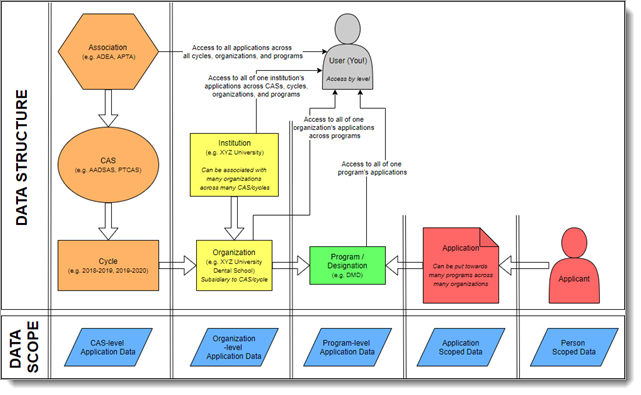CAS Application Data Structure and Data Integration
The way that your applicants' data and documents are stored in Liaison's database affects how you can interact with them in your data integration. Understanding the CAS data structure can help you design a more effective integration. Through decisions you make when configuring your programs, you have some measure of control over how your CAS application data is structured. For guidance on configuring your CAS application to make data integration easier, see the Collecting Applicant Data topic in this Help Center.

CAS Application Data Structure
The CAS application data structure accommodates information about (a) academic programs and (b) applicants to those programs. What follows is a brief overview of the CAS application data structure.
A centralized application service (CAS) starts with an association, which will encompass all academic years and programs. Some associations have more than one CAS. Associations can be a professional association like ADEA or APTA, an individual institution like Cal State or Montana University System, or Liaison International itself. An association sponsors a CAS, which spans academic years and programs. Each cycle, or academic year (like 2023-2024), within a CAS is a distinct item. The CAS/cycle combination is the bedrock of the CAS application data structure.
Within a CAS/cycle combination, participating schools are called organizations. Within a national CAS sponsored by a professional association like PTCAS, each organization is an individual university/college or school within an individual university/college. Organizations roll up into institutions. While organizations are confined to CAS/cycle combinations, an institution can be associated with many organizations across many CAS/cycle combinations. For example, "XYZ University Dental School" is an organization in ADEA AADSAS 2023-2024, and "XYZ University College of Health Professions" is an organization in PTCAS 2023-2024, and both are associated with the institution "XYZ Institution."
Organizations offer courses of study to applicants called programs. Each organization may have a single program or many programs, depending on the CAS. Organizations and programs are configured by users of the system (like you!). CASs and cycles are configured by Liaison. As each new cycle arrives, the user-configured items—organizations, programs, and everything underneath them—need to be rolled over.
Applicants create an application by creating an account and selecting at least one program to apply to within a certain CAS/cycle combination. An applicant can use a single application to apply to many different programs. While it is possible for an applicant to roll over some information from an application in an old CAS/cycle combination to a new one, a new application record will be created for each CAS/cycle combination.
Access to Data Matches the Structure
A user's access to CAS application data matches the data structure. Association-level users can access all application data across cycles, organizations, and programs. An institution-level user can access all application data for all associated organizations across CAS/cycle combinations and programs. Organization-level users can access all application data across programs. Program-level permissions restrict organization-level users from viewing application data for certain programs. An applicant, of course, only has access to their application, which can be put towards any number of programs within a CAS/cycle combination.
Data Scopes
Each document and piece of CAS application data is scoped to one of the five elements detailed above:
- Person-scoped
- Application-scoped
- CAS-level
- Organization-level
- Program-level
Person-scoped vs. Application-scoped
Applicant information can pertain to the person completing the application or be specific to the program applied to. Person-scoped information is relevant about the applicant regardless of the program applied to. Data points like name, mailing address, and employment history, and documents like college transcripts and resumes, are person-scoped. Application-scoped information is relevant to an applicant but only for an application to a specific program. Data points like start term, program applied to, and degree level, and documents like essays and letters of recommendation, are application-scoped.
CAS-level, Organization-level, and Program-level
Both scopes can be collected in a CAS at different levels. Some data and documents are collected from all applicants to a CAS, and individual schools aren't able to change these requirements during an active cycle. For example, collecting basic biographic information like name and birth date happens at the CAS-level; some document collection also happens at the CAS-level, with the association deciding to ask all applicants to submit certain documents. Participating schools also can customize applications to their programs. They can ask custom questions and make special requests for documents. When these custom requirements are added at the organization level, they're required from all applicants to any programs under the organization. Alternatively, an organization can create custom requirements at the program level, in which case they'll only be asked of applicants to that specific program. Sometimes, participating schools will ask for additional information that's already asked about at the CAS level. For example, some programs require additional letters of recommendation beyond what is required at the CAS level.
Programs: Where It All Comes Together
The program is where the applicant data intersects with the academic program data. Significantly, an applicant can only apply once to a program within a cycle. The program/application combination is the basic unit for a CAS data integration: each program/application combination will contain all of the relevant data and documents for a single application to an academic program. When designing your data integration, understanding where data and documents fit in the CAS application structure will help you grab the data you need, transform it to meet local system requirements, and upload it successfully to your local systems.
